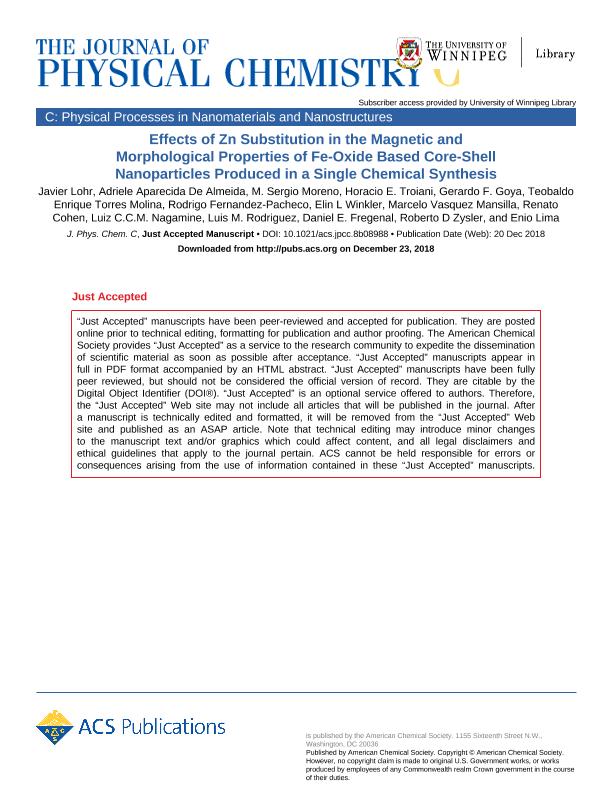Artículo
Effects of Zn Substitution in the Magnetic and Morphological Properties of Fe-Oxide-Based Core-Shell Nanoparticles Produced in a Single Chemical Synthesis
Lohr, Javier Hernán ; de Almeida, Adriele Aparecida
; de Almeida, Adriele Aparecida ; Moreno, Mario Sergio Jesus
; Moreno, Mario Sergio Jesus ; Troiani, Horacio Esteban
; Troiani, Horacio Esteban ; Goya, Gerardo Fabian; Torres Molina, Teobaldo Enrique
; Goya, Gerardo Fabian; Torres Molina, Teobaldo Enrique ; Fernandez Pacheco, Rodrigo; Winkler, Elin Lilian
; Fernandez Pacheco, Rodrigo; Winkler, Elin Lilian ; Vasquez Mansilla, Marcelo
; Vasquez Mansilla, Marcelo ; Cohen, Renato; Nagamine, Luiz C. C. M.; Rodriguez, Luis Miguel
; Cohen, Renato; Nagamine, Luiz C. C. M.; Rodriguez, Luis Miguel ; Fregenal, Daniel Eduardo
; Fregenal, Daniel Eduardo ; Zysler, Roberto Daniel
; Zysler, Roberto Daniel ; Lima, Enio Junior
; Lima, Enio Junior
 ; de Almeida, Adriele Aparecida
; de Almeida, Adriele Aparecida ; Moreno, Mario Sergio Jesus
; Moreno, Mario Sergio Jesus ; Troiani, Horacio Esteban
; Troiani, Horacio Esteban ; Goya, Gerardo Fabian; Torres Molina, Teobaldo Enrique
; Goya, Gerardo Fabian; Torres Molina, Teobaldo Enrique ; Fernandez Pacheco, Rodrigo; Winkler, Elin Lilian
; Fernandez Pacheco, Rodrigo; Winkler, Elin Lilian ; Vasquez Mansilla, Marcelo
; Vasquez Mansilla, Marcelo ; Cohen, Renato; Nagamine, Luiz C. C. M.; Rodriguez, Luis Miguel
; Cohen, Renato; Nagamine, Luiz C. C. M.; Rodriguez, Luis Miguel ; Fregenal, Daniel Eduardo
; Fregenal, Daniel Eduardo ; Zysler, Roberto Daniel
; Zysler, Roberto Daniel ; Lima, Enio Junior
; Lima, Enio Junior
Fecha de publicación:
01/2019
Editorial:
American Chemical Society
Revista:
Journal of Physical Chemistry C
ISSN:
1932-7447
Idioma:
Inglés
Tipo de recurso:
Artículo publicado
Clasificación temática:
Resumen
Magnetic, compositional, and morphological properties of Zn-Fe-oxide core-shell bimagnetic nanoparticles were studied for three samples with 0.00, 0.06, and 0.10 Zn/Fe ratios, as obtained from particle-induced X-ray emission analysis. The bimagnetic nanoparticles were produced in a one-step synthesis by the thermal decomposition of the respective acetylacetonates. The nanoparticles present an average particle size between 25 and 30 nm as inferred from transmission electron microscopy (TEM). High-resolution TEM images clearly show core-shell morphology for the particles in all samples. The core is composed by an antiferromagnetic (AFM) phase with a Wüstite (Fe 1-y O) structure, whereas the shell is composed by a Zn x Fe 3-x O 4 ferrimagnetic (FiM) spinel phase. Despite the low solubility of Zn in the Wüstite, electron energy-loss spectroscopy analysis indicates that Zn is distributed almost homogeneously in the whole nanoparticle. This result gives information on the formation mechanisms of the particle, indicating that the Wüstite is formed first, and the superficial oxidation results in the FiM ferrite phase with similar Zn concentration than the core. Magnetization and in-field Mössbauer spectroscopy of the Zn-richest nanoparticles indicate that the AFM phase is strongly coupled to the FiM structure of the ferrite shell, resulting in a bias field (H EB ) appearing below TN FeO , with H EB values that depend on the core-shell relative proportion. Magnetic characterization also indicates a strong magnetic frustration for the samples with higher Zn concentration, even at low temperatures.
Palabras clave:
Nanoparticles
,
Bimagnetic
,
Fe-Oxide based
Archivos asociados
Licencia
Identificadores
Colecciones
Articulos (UE-INN - NODO BARILOCHE)
Articulos de UNIDAD EJECUTORA INSTITUTO DE NANOCIENCIA Y NANOTECNOLOGIA - NODO BARILOCHE
Articulos de UNIDAD EJECUTORA INSTITUTO DE NANOCIENCIA Y NANOTECNOLOGIA - NODO BARILOCHE
Articulos(CCT - PATAGONIA NORTE)
Articulos de CTRO.CIENTIFICO TECNOL.CONICET - PATAGONIA NORTE
Articulos de CTRO.CIENTIFICO TECNOL.CONICET - PATAGONIA NORTE
Articulos(UE-INN)
Articulos de UNIDAD EJECUTORA INSTITUTO DE NANOCIENCIA Y NANOTECNOLOGIA
Articulos de UNIDAD EJECUTORA INSTITUTO DE NANOCIENCIA Y NANOTECNOLOGIA
Citación
Lohr, Javier Hernán; de Almeida, Adriele Aparecida; Moreno, Mario Sergio Jesus; Troiani, Horacio Esteban; Goya, Gerardo Fabian; et al.; Effects of Zn Substitution in the Magnetic and Morphological Properties of Fe-Oxide-Based Core-Shell Nanoparticles Produced in a Single Chemical Synthesis; American Chemical Society; Journal of Physical Chemistry C; 123; 2; 1-2019; 1444-1453
Compartir
Altmétricas



